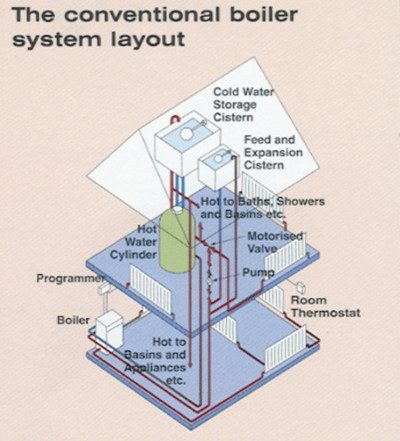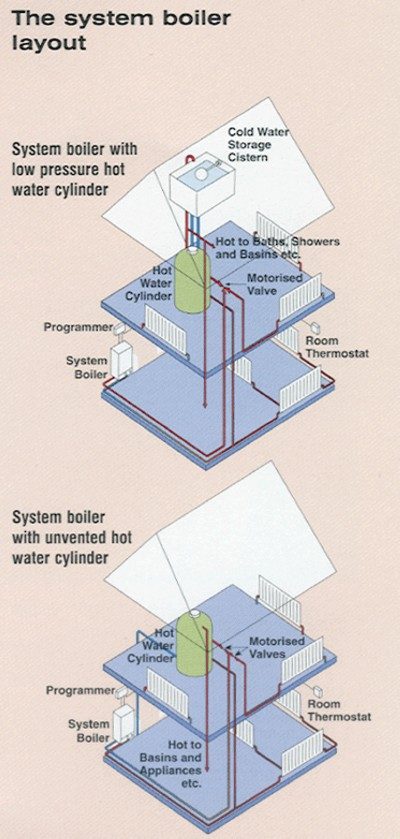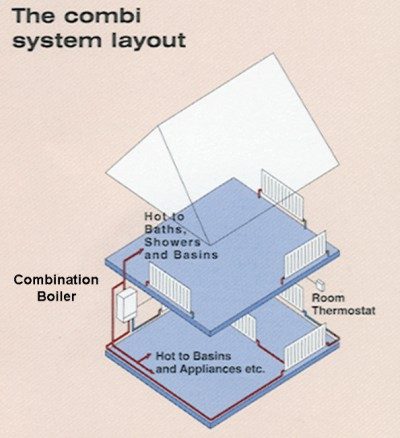Boiler System Choices

Choosing a new boiler
Choosing a new boiler when you don’t already have one, or choosing a replacement boiler for an existing central heating system can be confusing, but don’t be daunted!
The size and type of construction of your home are more important factors and you’ll need the help of a professional to help calculate the amount of heat the boilers must produce to keep you cosy in even the most extreme weather. You also need to consider your family size, and your lifestyle.
With a little help from Blue Flame, you can form a view on which type of boiler/system is best suited to your needs.
Whichever system is decided upon, in the majority of homes the boiler will
need to be a new high efficiency, condensing -type of boiler.
What are the benefits of a new high efficiency boiler?
Changes to government legislation and technology advances in boiler design has driven boiler designs to condense to ensure as much heat as possible is converted into useful heat for your home.
New condensing boilers will be ‘A’-rated appliances and will be 90-98% efficient with energy consumption dropping by up to 30% compared to an old heating installation.
In simple terms, for every £1 spent on your heating bills, over 90p is used to heat your home and hot water – a much better return than before. Very useful, particularly with the increases we’ve seen in energy bills in the recent past and much better for the environment too!
SEDBUK stands for Seasonal Efficiency of Domestic Boilers UK. It provides a rating structure which provides both a percentage efficiency score as well as A to G rating enabling an easy comparison of boilers. SEDBUK has been integrated to the recent ErP labelling directive.
How does it work then?
Condensing boilers use less gas by advances in boiler technology. Whereas the older, standard-efficiency boilers used to expel their products of combustion (flue gases) straight out into the atmosphere, the high efficiency condensing boilers re-use the heat from those flue gases already generated by passing them back through the boiler, to help to heat the system water. The flue gases are now discharged on their second cycle and at a much lower temperature so that they now start to turn to water vapour, so a “plume” of steam can be seen from the flue terminal, and drops of water are run into a drain or a purpose-provided soak-away.
So which type of condensing boiler is right for me?
There are 3 categories of boiler and two types of system – conventional and system boilers using a stored hot water cylinder, and a combination boiler which delivers instantaneous hot water – so you need to consider how you use the hot water now and possibly in the future (perhaps as the family grows, or grows up and leaves home).
So let’s look at these in more detail……
Combination (or combi) boilers



Hot water is instead heated instantaneously when a tap is turned on (so you don’t have to keep stored water topped-up or wait for the hot water cylinder to heat up). You’ll never run out of hot water, plus you’ll be able to have a shower at mains pressure too. It can, however, take longer to deliver a bath full of hot water, whilst simultaneous use of more than one tap can result in the flow of water being diminished somewhat to the other outlets.
A couple’s hot water needs are likely to be modest, using relatively small amounts – in which case a combination boiler is possibly the most suitable option particularly given the compact design nature of combination boilers.
Alternatively, for homes with a larger demand you could choose to install an un-vented hot water cylinder.
It must be remembered that both combination boilers and un-vented hot water cylinders are dependent upon the mains water pressure being provided by the local water authority (see below) but they do eliminate the risk of pipes freezing in the loft and frees up loft space for a loft conversion, for instance.
Combination boiler models provide different flow rates. The flow rate is the volume of hot water delivered at the taps in a minute and is determined by the amount (and pressure) of water that is entering your property. The more powerful the boiler is (represented in kW), the faster the boiler will be able to heat the water coming into your home.
However, it is important to be aware that a boiler with a high kW output will not always increase the available flow rate. For example, if your boiler has a maximum design flow rate of 16 litres per minute but you have 12 litres per minute of cold mains water entering your property, you will only be able to receive a maximum of 12 litres per minute of hot water.
Conventional boilers (regular or open vent)
A conventional (also known as regular or heat-only) boiler is connected to an open-vented central heating system with a header tank (normally) in the loft space, which operates in conjunction with a hot water storage cylinder and external controls, and can deliver plenty of hot water to several taps simultaneously.
A family with a very high hot water demand i.e. multiple hot water usage at once, is almost certain to be better served by a traditional, conventional boiler and system.
Please remember that if you are considering a conventional boiler, an important requirement is the need for a cold water storage tank (normally loft space will be required) plus room to locate the hot water cylinder (and to possibly build an airing cupboard?).
Conventional boilers work on a much lower system pressure than that of a Combi or System boiler and are compatible with solar water heating systems for lower energy costs and a lower carbon footprint.
System boilers
A system boiler is similar to the conventional boiler, except that the central heating system is sealed and pressurised (no header tank), and the system boiler would normally have the pump and some or all of the system controls integrated into it.
System Updates
Do you need the space where your airing cupboard is, or if you’re carrying out a loft conversion does the builder needs the cold water tank out of the way? Then contact Blue Flame Gas Services to provide you with a FREE estimate to convert your conventional system to a combination system, plus to give you energy efficiency tips and advice to reduce your running costs.
Magnetic system filters
Building Regulations always recommends that a magnetic system filter is to be fitted onto your central heating system to prevent any damage to any new boiler and its components.
Over time, central heating system water accumulates harmful dirt and debris, such as rust and solder fragments shed by radiators and boilers, all of which can cause considerable problems.
Correct water quality and treatment is of paramount importance to a healthy heating system and the importance of using a magnetic system filter is a key component to improving the efficiency of the boiler and central heating system overall.
A magnetic system filter is a specifically designed unit which aims to remove and filter magnetic and non-magnetic contaminants from your central heating system before they reach your boiler and dramatically reduces the damaging effects of system debris and pollutants.
Please also see the page which describes the process of Power Flushing.
System controls
Smart thermostats and digital controls offer many features and whilst these improve the overall performance of your heating system they also make sure that the boiler always maintains its optimum efficiency.
Thermostatic radiator valves (TRVs) enable you to control the individual temperature of each room in your home, and can be adjusted to suit the comfort levels in each room of your home.
Do please be aware that a TRV should not be fitted on a radiator in the same room as where the room thermostat is located because if it is turned down to its frost setting the room thermostat will never “satisfy” and the boiler will continue to run and waste heat and energy.